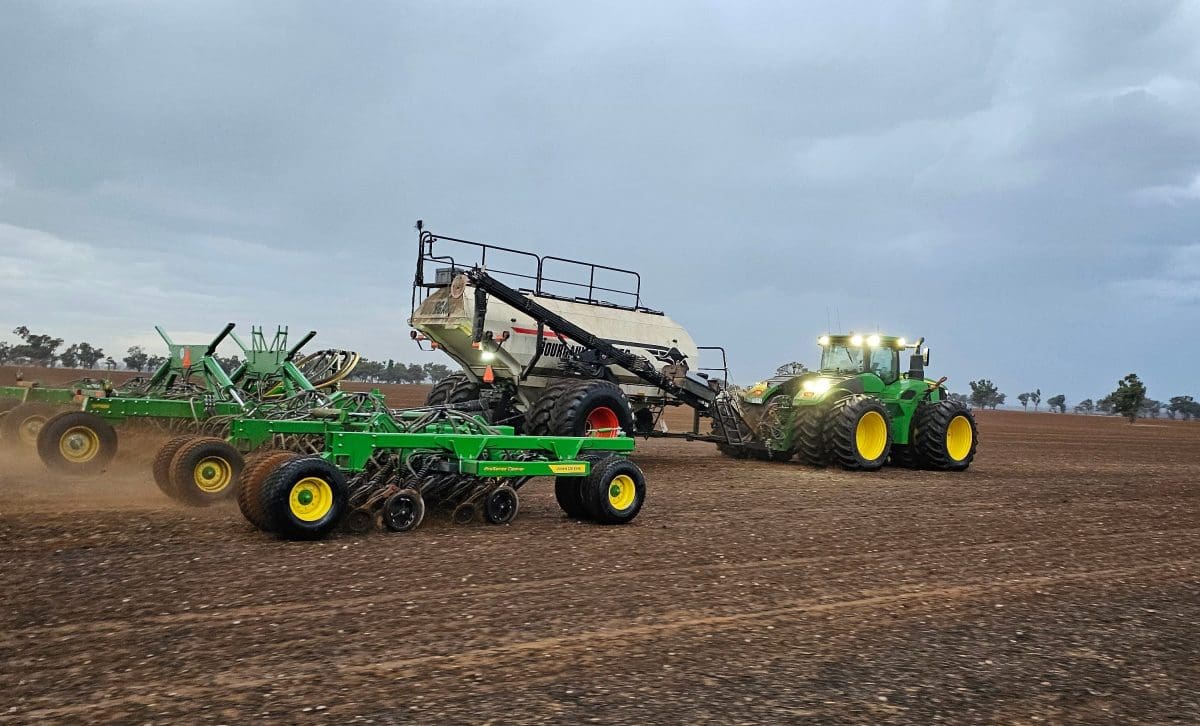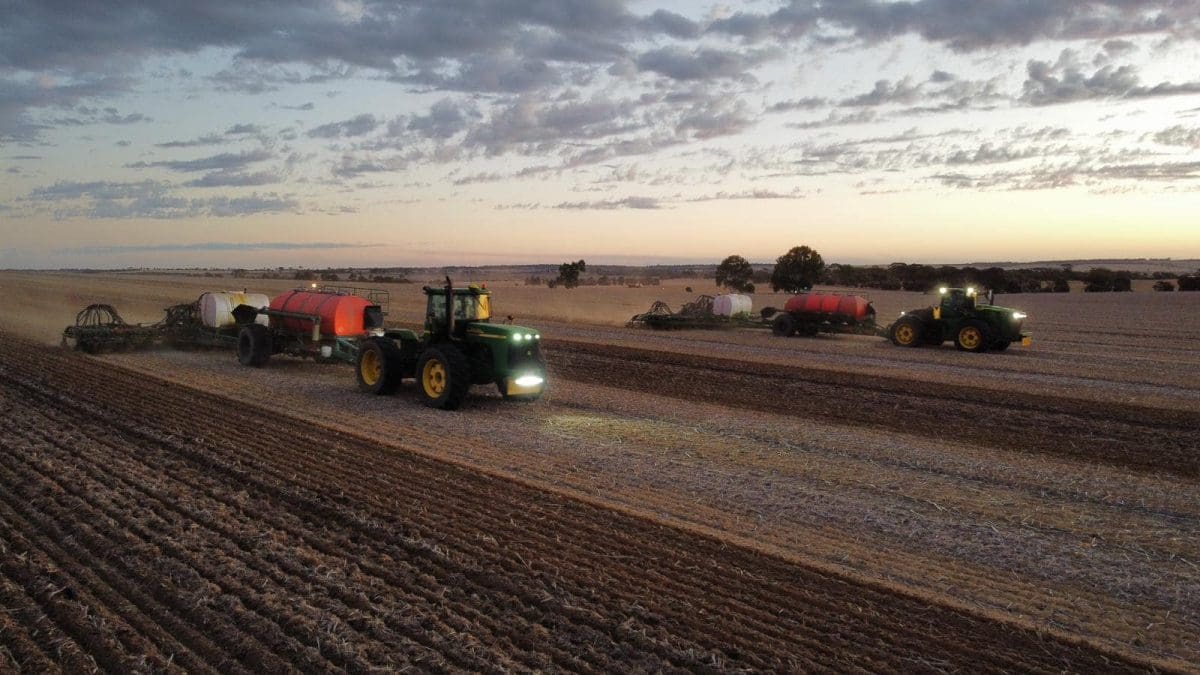
Seeding for most growers on the south-west slopes of NSW is over, and finished at the Holland family’s operation on 21 May. Photo: Broden Holland
A LACK of topsoil moisture in northern New South Wales is holding up completion of Australia’s new-crop sowing program.
However, most growers are finished, or close to it, in other parts of the nation’s grainbelt.
The Australian canola crop has been planted on time and in mostly ideal conditions by late April, but a relatively dry May in all regions but southern Queensland has arrested sowing and germination of some cereals.
The window for sowing wheat, barley and chickpeas remains open well into June, but precious little rain is forecast for the drier regions in the near term.
Ahead of ABARES releasing its first forecast for 2023-24 winter crops on June 6, growers, traders and consumers are all conscious that El Niño conditions may well be developing in stark contrast to last year’s mild and wet La Niña season.
Australian Crop Forecasters has estimated new-crop wheat area at 13.7 million hectares (Mha) to yield 27.9 million tonnes (Mt), with barley seen at 4.4Mha to yield 10.5Mt.
“We’ve got total winter-crop area largely unchanged after a good start in most states saw seeding start early,” ACF senior insights manager James Maxwell said.
“Wheat and barley areas are similar to last season, but canola area is back 7 percent, in part due to lower prices but also the drier outlook.”
ACF has used 10-year average yields to generate production forecasts.
“The five-year average includes the past three record seasons, so that isn’t realistic particularly given the dry outlook.”
Mr Maxwell said production appears to have some downside based on the forecasts indicating below-average in-crop rainfall.
“One point for further down the road is that lack of rainfall generally means a higher risk of frost events in spring.”
USDA this month issued its initial forecast for new-crop Australian wheat at 29Mt, down 26pc from the record 39Mt 2022-23 crop.

Seeding in Western Australia is over for most growers including Fulwood Grain Company in the central wheatbelt. Read about WA’s outlook in the GIWA report released May 19. Photo: Christoph Hessing
Queensland
Central Queensland grows only two major winter crops, chickpeas and wheat.
Iker Ag Consulting agronomist Belinda Chase said the region has seen a huge drop in area planted to chickpeas, and most of the intended wheat area is in the ground and off to a strong start.
“I’d say 90 percent of the wheat would be in, and those that haven’t finished would be looking to moisture-seek by sowing chickpeas,” Ms Chase said.
“There are still a few guys on the tail end of planting.”
Ms Chase said most growers have stored subsoil moisture after fallowing over the summer, and were able to plant wheat at the ideal time.
“They’ve had a shower here and there, and they’ve started doing in-crop sprays.
She said most of the region’s wheat and chickpeas have established well.
This puts the region on track to harvest in September to open the national new-crop offering.
In southern Queensland, AgForce grains president and Warra grower Brendan Taylor said good rain across much of the Downs earlier this month has allowed most growers to plant all of their intended area to wheat, barley and chickpeas.
“Some people are only starting again this week, or last week, because it got too wet to keep planting,” Mr Taylor said.
While CQ chickpea area is down markedly, the southern Qld area could well be up, and crops will be planted well into June.
“We haven’t grown any chickpeas for a number of years, but we’ve had really heavy barley stubble two years running, and it would be an issue for us if we tried to plant another cereal.”
“There was a lot of disease in cereals last year, and growers are conscious of that.”
Mr Taylor is one of many across eastern Australia who has noted the change in the feel of the season, with some heavy frosts having settled already, and clear and warm days.
New South Wales
In northern NSW, Nutrien Ag Solutions Narrabri agronomist Dylan Verrier said some growers were yet to start planting wheat in country west of the Newell Highway.
“As soon as you go west of Narrabri, it gets very patchy, but Walgett and west has had a bit of rain in spots,” Mr Verrier said.
“East of Narrabri is not so bad, but people are definitely concerned.
“That’s reflected in the price of livestock; people are joining less heifers, or selling stock.
“They don’t want another 2017, 18 and 19.”
Those years saw the northern half of NSW gripped by drought, and several million tonnes of high-protein wheat removed from the state’s balance sheet as a result.
With chickpea prices being unimpressive, canola area for northern region again looks like being big, but rain is needed soon to shore up its yield prospects.
“Some places just didn’t have the moisture to plant canola…and crops planted in April really need a drink.
“In Narrabri, we had 21mm in April, and we’ve had nothing in May.
“Some of my blokes haven’t had proper rain since harvest.”
Faba beans have domestic as well as export marketing options, and Mr Verrier said some crops were planted at 15cm or more to get into subsoil moisture.
“Some fabas are doing alright if they went in in April.”
North-west NSW can grow large tonnages of durum, but low prices couple with the risk of running into disease problems looks like severely limiting area this season.
“People will steer away from durum because we had a heap of fusarium head blight last year.
“If we get rain in June, it’ll be chickpeas and barley that go in, not durum.
“If we get a bit of rain in mid-August people will look at whacking some sorghum in in mid-September.
Conditions in southern NSW are generally good, but a shower or two would consolidate early yield prospects for the region’s crops, all sown well and truly on time, and with good subsoil moisture beneath them;
“Most of our guys are 80pc finished, or finished,” Delta Ag Temora agronomist Mark Breust said.
“Everything went in on time, and there were lots of issues with slugs, some mice, and a bit of lucerne flea,” Mr Breust said.
That called for some areas of resowing, but crops are now generally well established.
“Some follow-up rain now would be good to make sure our pre-emergents have worked, and to get some top dressing going.
“Conditions are certainly drying out.”
Mr Breust said a few more vetch and oat crops were going in for grazing, and to get on top of ryegrass as a hard-to-control weed in cash crops.
Victoria
In Victoria’s Wimmera, Nutrien Ag Solutions Rupanyup agronomist Brad Jackson said most growers were into their final third of planting, with mostly lentils left to go in.
“A few growers have finished, and the big guys are mostly two-thirds to three-quarters finished.”
Showers late last week delivered 8-12mm to some paddocks, and will be enough to germinate sown dry sown crops.
The ideally timed rain also spread into parts of South Australia, where planting progress was outlined last week in the Grain Producers SA survey results.
“There’s a bit of a north-south divide; south of the Wimmera Highway, crops are still going into moisture, and some of the lentils have been punched in deep to get them to it.”
Mr Jackson said canola sown prior to Anzac Day was looking good, but some planted this month is yet to germinate.
“We haven’t had anyone that’s pulled up on planting because of a lack of moisture in the Wimmera …but they’ve just been doing bankers’ hours.”
“In the Mallee, some growers have pulled up because it’s gotten too dry.”
Mr Jackson said clear skies and big frosts were having an impact on topsoil moisture levels.
“We’ve had a few days in the low to mid 20s, and some ripping frosts that have dried that top 10cm right out.”
“If we can get the two bands of moisture joined up, and keep the frost and heat away, we’re in for another good year.”
Grain Central: Get our free news straight to your inbox – Click here

HAVE YOUR SAY